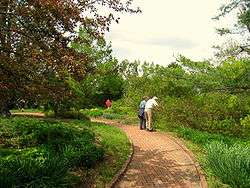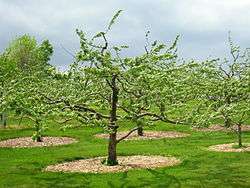Tower Hill Botanic Garden



The Tower Hill Botanic Garden (THBG) is located in Boylston, approximately 8 miles (13 km) north of central Worcester in Worcester County, Massachusetts.[1]
The THBG is a 132 acres (53 ha) botanic garden and arboretum, with views of the Wachusett Reservoir and Mount Wachusett. It was founded in 1986 on the former Tower Hill Farm site by the Worcester County Horticultural Society, which maintains its headquarters here and is the third oldest horticultural society in the U.S.[2][3]
Features
The Stoddard Education and Visitors Center — the hub for visitor activities at the Tower Hill Botanic Garden. The complex houses: Twigs Cafe and Gift Shop; the 100-seat Theater showing an orientation video for visitors; and the Tower Hill Library with horticulture, gardening, and botany books, magazines, dvds, and archival materials.[4]
Collections and gardens
The Tower Hill Botanic Garden has a variety of themed specialty gardens and focused plant collections, they include:[5][6][7]
- The Entry Gardens — an introductory garden with vibrant displays of annuals and tender plants with the permanent collection of ornamental, edible and native plants. It uses the E. Stanley and Alice M. Wright Entry Garden and the Thomas Smith W. Robert Mill Entry Court to introduce visitors to the botanic garden beyond the Stoddard Education and Visitors Center at its terminous.[8]
- The Winter Garden — a 14,000-square-foot (1,300 m2) courtyard garden enclosed on three sides by the Stoddard Education and Visitors Center, the Orangerie, and the Limonaia. It features plants especially known for their winter attributes, and the formal Domitian’s Pool centered in the courtyard has twin bronze sculptures of native Eastern Box Turtles as fountain jets.[9]
- The Orangerie — a 4,000 square foot (370 m2) orangerie greenhouse, a hybrid of an 18th century Neoclassical orangerie and a modern conservatory. It is Tower Hill’s primary climate controlled wintertime display facility, featuring hundreds of sub-tropical plants and blooming bulbs.[10]
- The Limonaia — a conservatory greenhouse displaying a portion of THBG’s collection of non-hardy plants that need to winter in a sub-tropical environment, including potted lemon trees.[11]
- The Cottage Garden — the first garden designed and planted at THBG in the 1980s. It emphasizes color combinations, with a variety of trees, shrubs, bulbs, herbaceous perennials, annuals, and ornamental grasses for shade & sun, and moist & dry conditions. Its smaller scale, similar to residential gardens, is a place of ideas for home gardeners and garden designers.[12]
- The Lawn Garden — 2 terraces of grassy greensward bordered by over 350 species and varieties of ornamental trees and shrubs, underplanted with: sweeps of perennials including peonies, day lilies, & iris; and diverse ground covers.[13]
- The Secret Garden — an enclosed oval garden on the third and lowest terrace of the Lawn Garden, with twin pergolas, a garden pool and fountain, a wide variety of ornamental grasses, annual plants, and tender and low maintenance perennial plants.[14]
- The Inner Park — a native plant garden and mixed hardwood trees woodland, with pathways and Classical Revival style architectural elements, including the Peace Temple, a garden folly, the Pope Urn, and statuary.[15]
- Pliny’s Allée — a landcape allée of oak trees, underplanted with shrubs of notable autumn beauty, and two busts of Janus, the Roman deity of beginnings and endings. Pliny’s Fountain, an antique stone wellhead that periodically erupts a jet of water is at the allée'a terminous.[16]
- The Vegetable Garden — a seasonal vegetable garden containing unusual and heirloom vegetables, herbs, and annual flowers.[17]
- The Systematic Garden — a one-of-a-kind botany educational experience designed in an Italian Renaissance garden style, with plants arranged 'systematically' according to current taxonomy understandings of their evolutionary relationships. This garden displays plant species in 26 distinct plant families as a visual encyclopedia of the Plant Kingdom.[18]
- The Wildlife Garden — with 0.5 acres (0.20 ha) with 3 miles (4.8 km) of woodland trails, it provides opportunities for visitors to observe and contemplate the natural world. Both native plant and exotic species are incorporated into this wildlife garden. The Bird House is a screened building for visitors to enjoy bird watching without the bother of mosquitoes and other flying insects. Cross-country skiers are welcome here in winter.[19]
- The Wildlife Refuge Pond — a 0.5 acres (0.20 ha) pond with wetlands that provides drinking water and habitat to wild birds, native amphibians, and indigenous species of fish. The Rustic style Viewing Pavilion is a vantage point for wildlife viewing.[20]
- The Moss Steps — a carpet of moss that grew to cover the Castalia stone steps underneath, located in the Edward Mezitt Shade Garden. The limestone rocks are from farm fields in Sandusky County, Ohio. The area framing the steps has been planted with Mountain Laurel (Kalmia latifolia), and native ferns and wildflowers.[21]
- The Harrington Apple Orchard — displaying the Davenport Collection of heirloom apples, with 238 apple trees representing 119 pre-20th century heritage apple varieties.[22]
- The Court: A Garden Within Reach — a universally accessible garden space for all, with plantings chosen for their multi-sensory appeal. It has innovative moveable planters, more accessible raised beds, and a vertical green wall.[23]
- The Asian Woods — with Asian and Eurasian woodland counterparts to native North American flora.[24]
- The Field of Daffodils — a field of more than 25,000 daffodil bulbs creating a tapestry of color. It comes into bloom in late April, with the bloom period 'usually' peaking between the 3rd week of April and the 1st week of May.[25]
Cary Award
The Cary Award program promotes outstanding plants for New England gardens. It is a collaborative effort of the Tower Hill Botanic Garden−Worcester County Horticultural Society, the Massachusetts Horticultural Society, the New England Nursery Association, and the Massachusetts Nursery and Landscape Association. it highlights home landscape ornamental plants that have proven their performance in New England.[26][27]
See also
- Botanical gardens in Massachusetts
- List of botanical gardens in the United States
- Tourist attractions in Worcester County, Massachusetts
References
- ↑ "THBG.org: Tower Hill Botanic Garden". www.towerhillbg.org.
- ↑ THBG.org: Tower Hill Botanic Garden history & mission
- ↑ Facebook page of Worcester County Horticultural Society
- ↑ THBG.org: Tower Hill Library
- ↑ Map of the Tower Hill Botanic Garden
- ↑ THBG.org: Plant collections & gardens descriptions
- ↑ THBG.org: Plant collections & gardens image galleries
- ↑ THBG.org: The Entry Garden (The E. Stanley and Alice M. Wright Entry Garden & Thomas Smith W. Robert Mill Entry Court)
- ↑ THBG.org: The Winter Garden
- ↑ THBG.org: The Orangerie
- ↑ THBG.org: The Limonaia
- ↑ THBG.org: The Cottage Garden
- ↑ THBG.org: The Lawn Garden
- ↑ THBG.org: The Secret Garden (Edith J. Beals Secret Garden)
- ↑ THBG.org: The Inner Park (Palmer W. Bigelow, Jr. Inner Park)
- ↑ THBG.org: Pliny’s Allée
- ↑ THBG.org: The Vegetable Garden
- ↑ THBG.org: The Systematic Garden
- ↑ THBG.org: The Wildlife Garden
- ↑ THBG.org: The Wildlife Refuge Pond (Hope Spear Wildlife Refuge Pond)
- ↑ THBG.org: The Moss Steps
- ↑ The Harrington Apple Orchard (Frank L. Harrington Sr. Orchard)
- ↑ THBG.org: The Court: A Garden Within Reach (a universally accessible garden)
- ↑ THBG.org: The Asian Woods
- ↑ THBG.org: The Field of Daffodils
- ↑ THBG.org: The Cary Award program
- ↑ Caryaward.com: List of Cary Award winning plants

External links
| Wikimedia Commons has media related to Tower Hill Botanic Garden. |
Coordinates: 42°21′43″N 71°43′36″W / 42.3619°N 71.7267°W